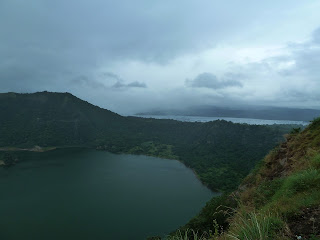Taal – Talisay and San Nicolas, Batangas, Philippines
Below the highlands of
Tagaytay, about 50 kilometers south of Manila, lays Taal, the second most
active volcano on the Philippine islands.
 |
| Taal Volcano |
Our visit began on a cloudy, misty morning in Tagaytay. We
had just arrived by bus after a three hour trip, and were eating at the local
McDonald's. It was the first time I had ever seen a volcano, so I was anxious to
find transportation down from the highlands. We hired two tricycles to take us
on the winding road leading down into the valley where Taal lake was situated.
Part of our purchase price was a trip across the lake on a motorized pontoon
boat that would take us to Volcano Island.
By the time we reached the lake, the mist had cleared and the
clouds had finally thinned some, letting a pale sun shine down on us. Climbing
onto the pontoon boat, they started the motor and our journey out across the
large lake began. Though the mist was gone, it didn’t prevent us from finding
ourselves damp from the spray caused by the small waves that continued to
strike the boat as we hurried across. It took about 15 minutes to cross the
lake to Volcano Island, and as we neared the shore, we could see a few other
pontoon boats moored at a small dock. On shore we saw one building just up from
the shore, which turned out to be a small welcome center for tourists. Besides
that one isolated building, there was only a village of tiny concrete houses and
huts, and an abundance of horses, which I soon found was the main mode of
transportation up to the top of the volcano.
It was only a few minutes before each of us was sitting atop
a small horse with our guide sitting directly behind us guiding the horse as it
traversed the worn and twisting trail up toward the volcano. The trail had seen
much use over the years, and in some areas there was a trench that had been
worn deep into the ground until it’s sides rose taller than the horse and
rider. Other times we walked beside vents of steam where the hot gases
continuously released into the air. It was an eerie feeling passing by those
vents, as if we had ventured into Dante’s own travels through Hell. The areas
around the vents were barren and rocky, though much of the island was covered
in lush green due to the rich volcanic soil.
After about a fifteen minute ride through the winding upwards
trail, we reached a narrow ridge, where off to one side was a few small
buildings resembling open pavilions that was filled with visitors. That is
where we dismounted the horses, and found ourselves gazing down into the active
volcano of Taal.
The caldera, or valley of the volcano was far below us, and
filled with a lake, and one tiny island called Vulcan Point situated in its
dark green waters. We could see steam rising up from the edges of the water,
and even along the volcano walls there were areas where we could see steam
being vented from openings in the ground. It was a beautiful site looking down
into the heated waters, and along the steep green cliffs that lined the
volcano’s interior. There was an oddly peaceful feeling in the quiet
surroundings, but beneath our feet the pressure was slowly building for another
eruption on this very active volcano.
Comments
Post a Comment